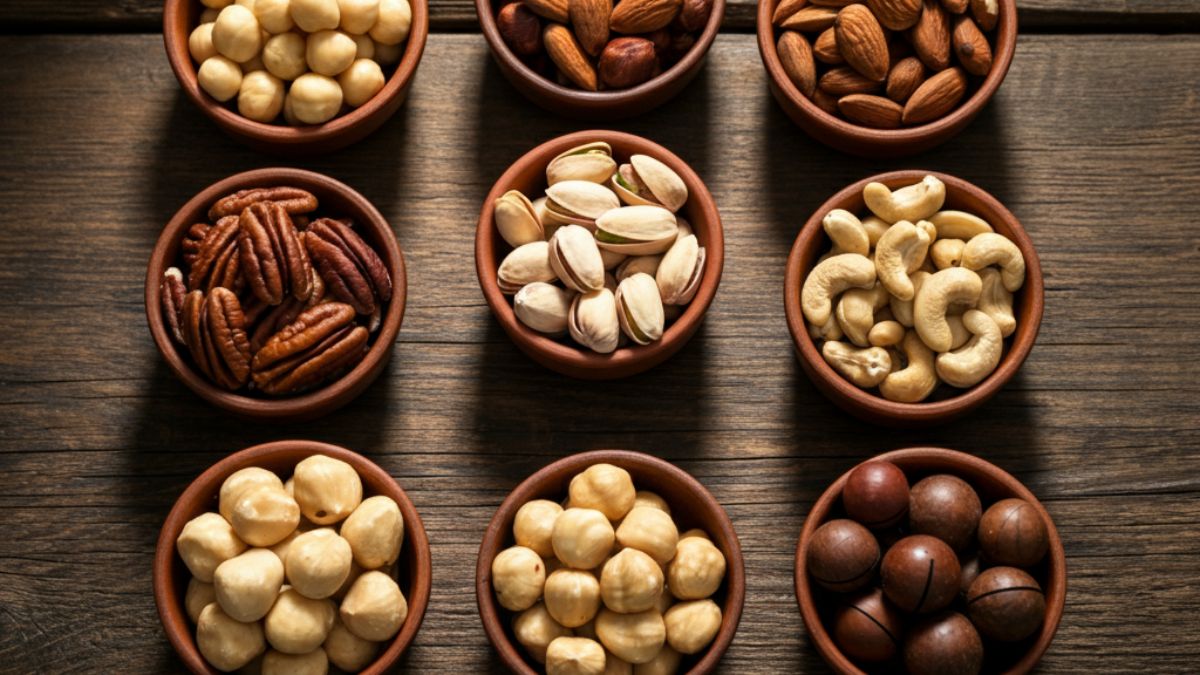Protein is an essential nutrient that helps build and repair tissues, supports muscle growth, and keeps your energy levels steady throughout the day. While most people associate High-Protein Nuts to Boost Your Diet with meat or dairy, nuts are a fantastic source of plant-based protein, packed with healthy fats, vitamins, and minerals.
If you’re looking to boost your protein intake while snacking smartly, we’ve got you covered. Below, we list nine protein-rich nuts you can add to your diet for a wholesome and satisfying boost.
The 9 Protein-Packed Nuts You Need
1. Almonds
Protein Content: 6 grams per ounce (approx. 23 almonds)
Almonds aren’t just protein powerhouses; they’re also rich in vitamin E, magnesium, and antioxidants. These crunchy delights are perfect for snacking, blending into smoothies, or even turning into almond butter.
How to Include Them
- Sprinkle chopped almonds over your oatmeal or yogurt.
- Swap potato chips with a handful of roasted almonds for a hearty snack.
2. Peanuts
Protein Content: 7 grams per ounce (about 28 peanuts)
Technically a legume but commonly categorized with nuts, peanuts boast the highest protein content on this list. They’re loaded with niacin and healthy fats, making them ideal for active days.
How to Include Them
- Spread natural peanut butter on whole-grain toast with bananas.
- Toss peanuts into savory dishes like stir-fries for added crunch.
3. Pistachios
Protein Content: 6 grams per ounce (approx. 49 pistachios)
Pistachios are a nutritional goldmine! With their vibrant green hue and subtle sweetness, they come packed with protein, vitamins B6, and potassium. Plus, their shell makes them a fun, portion-controlled snack.
How to Include Them
- Add cracked pistachios to your favorite salad or trail mix.
- Blend them into homemade pesto for a unique twist.
4. Cashews
Protein Content: 5 grams per ounce (about 18 cashews)
Creamy and delicious, cashews are rich in protein, iron, and zinc—essential nutrients that support immunity and energy metabolism. They also work wonders as a plant-based cheese or cream substitute!
How to Include Them
- Toss cashews into a veggie stir-fry for a nutty crunch.
- Blend into sauces, soups, or snacks for velvety texture and flavor.
5. Walnuts
Protein Content: 4.5 grams per ounce (approx. 14 halves)
Unlike most nuts, walnuts are renowned for their omega-3 fatty acids, which support brain function and heart health. While slightly lower in protein than others, their health benefits make them a must-have for any diet.
How to Include Them
- Mix walnuts into baked goods like banana bread or muffins.
- Crush and use as a crust for fish or chicken dishes.
6. Hazelnuts
Protein Content: 4 grams per ounce (about 21 nuts)
With a sweet, buttery flavor, hazelnuts are a delightful source of protein, copper, and manganese. They’re most famous for pairing beautifully with chocolate, but their natural taste is just as good on its own!
How to Include Them
- Snack on raw hazelnuts mixed with dried fruits.
- Blend into a nut butter or add to smoothies for a creamy flavor.
7. Brazil Nuts
Protein Content: 4 grams per ounce (about 6 nuts)
Brazil nuts are a unique source of selenium, a mineral essential for thyroid health and immune function. While they contain slightly less protein compared to other nuts, their selenium content alone makes them worth adding to your diet.
How to Include Them
- Enjoy 2-3 Brazil nuts daily for an easy selenium boost.
- Chop and sprinkle over your salads for added crunch.
8. Macadamia Nuts
Protein Content: 2 grams per ounce (about 10-12 nuts)
Macadamias often get overlooked for their lower protein content, but they are buttery, satisfying, and rich in monounsaturated fats that are great for heart health. Pair them with other nuts for a wholesome mix.
How to Include Them
- Blend into desserts like macadamia nut cookies or cheesecake.
- Roast and season with herbs for an indulgent snack.
9. Pine Nuts
Protein Content: 4 grams per ounce (approx. 167 nuts)
Pine nuts—commonly associated with pesto—are small but mighty. They’re rich in protein, magnesium, and iron. Adding them to meals delivers a toasted and nutty depth of flavor.
How to Include Them
- Toast pine nuts and scatter over pasta or roasted veggies.
- Blend into a homemade pesto for a protein-packed sauce.
Why Choose Nuts for Protein?
Adding high-protein nuts to your diet isn’t just about convenient snacking; it’s about incorporating nutrient-dense, plant-based foods into your everyday routine. Here are a few more benefits of nuts as a source of protein:
- Healthy Fats: Most nuts are loaded with heart-healthy fats like omega-3s and monounsaturated fats.
- Fiber-Rich: Nuts add fiber to your diet, promoting better digestion and satiety.
- Portable: They’re easy to carry, making them perfect for on-the-go snacking.
- Versatile: Whether added to meals or eaten solo, nuts adapt to all your culinary needs.
How to Enjoy Nuts Without Overindulging
While nuts are incredibly nutritious, they are calorie-dense. A small handful (about 1 ounce) is usually the recommended serving size. Here are some tips to keep your nut intake balanced and healthy:
- Pre-Portion your servings into snack baggies.
- Pair them with a source of carbohydrate or fruit for a balanced snack.
- Try unsalted or lightly salted nuts to keep sodium levels in check.
Start Snacking Smarter Today
Adding these high-protein nuts to your diet is a simple way to boost your nutrition without sacrificing flavor. Almonds for your morning boost, pistachios as a midday snack, or macadamia nuts in your dessert—the possibilities are endless!
Start mixing and matching your favorites to create your go-to high-protein snack. Your taste buds (and your body) will thank you.
FAQs
Q: Are nuts a good source of protein?
A: Yes, nuts are an excellent source of plant-based protein. They also provide healthy fats, fiber, vitamins, and minerals, making them a nutrient-dense snack.
Q: How many nuts should I eat in a day?
A: It’s recommended to stick to a 1-ounce serving per day, which is about 1 small handful. Portion control is key to avoiding excess calorie intake.
Q: Can I eat nuts if I’m on a low-sodium diet?
A: Absolutely! Opt for unsalted or lightly salted nuts to keep your sodium levels in check while still enjoying their nutritional benefits.
Q: Are roasted nuts less healthy than raw nuts?
A: Roasted nuts can be just as healthy as raw nuts, but keep in mind that some roasted varieties may be cooked in added oils or have added salt. Look for dry-roasted or unsalted options for a healthier choice.
Q: Can nuts help with weight loss?
A: While nuts are calorie-dense, they can support weight loss when consumed in moderation. Their high protein and fiber content can help you feel full and satisfied, reducing the likelihood of overeating.











